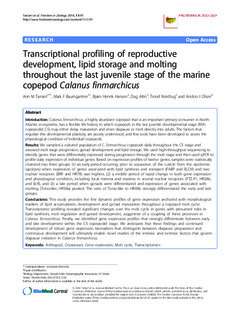| dc.contributor.author | Tarrant, Ann | |
| dc.contributor.author | Baumgartner, Mark | |
| dc.contributor.author | Hansen, Bjørn Henrik | |
| dc.contributor.author | Altin, Dag | |
| dc.contributor.author | Nordtug, Trond | |
| dc.contributor.author | Olsen, Anders Johny | |
| dc.date.accessioned | 2019-03-04T12:18:26Z | |
| dc.date.available | 2019-03-04T12:18:26Z | |
| dc.date.created | 2015-01-08T16:12:35Z | |
| dc.date.issued | 2014 | |
| dc.identifier.citation | Frontiers in Zoology. 2014, 11 (1), . | nb_NO |
| dc.identifier.issn | 1742-9994 | |
| dc.identifier.uri | http://hdl.handle.net/11250/2588474 | |
| dc.description.abstract | Introduction Calanus finmarchicus, a highly abundant copepod that is an important primary consumer in North Atlantic ecosystems, has a flexible life history in which copepods in the last juvenile developmental stage (fifth copepodid, C5) may either delay maturation and enter diapause or molt directly into adults. The factors that regulate this developmental plasticity are poorly understood, and few tools have been developed to assess the physiological condition of individual copepods. Results We sampled a cultured population of C. finmarchicus copepods daily throughout the C5 stage and assessed molt stage progression, gonad development and lipid storage. We used high-throughput sequencing to identify genes that were differentially expressed during progression through the molt stage and then used qPCR to profile daily expression of individual genes. Based on expression profiles of twelve genes, samples were statistically clustered into three groups: (1) an early period occurring prior to separation of the cuticle from the epidermis (apolysis) when expression of genes associated with lipid synthesis and transport (FABP and ELOV) and two nuclear receptors (ERR and HR78) was highest, (2) a middle period of rapid change in both gene expression and physiological condition, including local minima and maxima in several nuclear receptors (FTZ-F1, HR38b, and EcR), and (3) a late period when gonads were differentiated and expression of genes associated with molting (Torso-like, HR38a) peaked. The ratio of Torso-like to HR38b strongly differentiated the early and late groups. Conclusions This study provides the first dynamic profiles of gene expression anchored with morphological markers of lipid accumulation, development and gonad maturation throughout a copepod molt cycle. Transcriptomic profiling revealed significant changes over the molt cycle in genes with presumed roles in lipid synthesis, molt regulation and gonad development, suggestive of a coupling of these processes in Calanus finmarchicus. Finally, we identified gene expression profiles that strongly differentiate between early and late development within the C5 copepodid stage. We anticipate that these findings and continued development of robust gene expression biomarkers that distinguish between diapause preparation and continuous development will ultimately enable novel studies of the intrinsic and extrinsic factors that govern diapause initiation in Calanus finmarchicus. | nb_NO |
| dc.description.abstract | Transcriptional profiling of reproductive development, lipid storage and molting throughout the last juvenile stage of the marine copepod Calanus finmarchicus | nb_NO |
| dc.language.iso | eng | nb_NO |
| dc.publisher | Biomed Central | nb_NO |
| dc.rights | Navngivelse 4.0 Internasjonal | * |
| dc.rights.uri | http://creativecommons.org/licenses/by/4.0/deed.no | * |
| dc.title | Transcriptional profiling of reproductive development, lipid storage and molting throughout the last juvenile stage of the marine copepod Calanus finmarchicus | nb_NO |
| dc.type | Journal article | nb_NO |
| dc.type | Peer reviewed | nb_NO |
| dc.description.version | publishedVersion | nb_NO |
| dc.source.pagenumber | 15 | nb_NO |
| dc.source.volume | 11 | nb_NO |
| dc.source.journal | Frontiers in Zoology | nb_NO |
| dc.source.issue | 1 | nb_NO |
| dc.identifier.doi | 10.1186/s12983-014-0091-8 | |
| dc.identifier.cristin | 1193421 | |
| dc.description.localcode | © Tarrant et al.; licensee BioMed Central. 2014. This article is published under license to BioMed Central Ltd. This is an Open Access article distributed under the terms of the Creative Commons Attribution License (http://creativecommons.org/licenses/by/4.0), which permits unrestricted use, distribution, and reproduction in any medium, provided the original work is properly credited. | nb_NO |
| cristin.unitcode | 194,66,10,0 | |
| cristin.unitname | Institutt for biologi | |
| cristin.ispublished | true | |
| cristin.fulltext | original | |
| cristin.qualitycode | 1 | |

